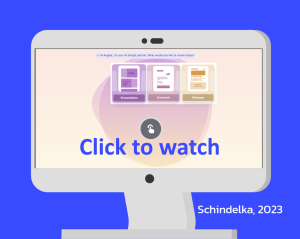14 Transforming Learning Opportunities with Gamma Presentations
Angela Schindelka
Introduction
In the era of apps and ads competing for everyone’s attention, gaining and keeping the attention of learners is exceedingly challenging. Thanks to the AI-enhanced features of Gamma, educators can create engaging multimedia presentations in just a few minutes, leaving more time for the parts of their roles that truly need a human touch. In addition to increasing efficiency, these presentations may help provide more effective and societally relevant learning experiences.
Gamma has all the formatting features of traditional presentation software, but simplifies the design process and allows for more interactive editing, additions, and analytics thanks to its AI capabilities. Users can converse with Gamma’s AI chatbot, which uses OpenAI’s ChatGPT, to easily make adjustments that suit their needs and preferences. Gamma makes it easy to include concise explanations, multimedia, and clear charts and diagrams; these components are particularly useful for educators with interest in short lessons and other forms of microlearning (Ai-dung & Hung, 2022), as well as Universal Design for Learning (UDL), which seeks to have all learners benefit from the learning opportunities presented (CAST, 2018). Teaching the responsible use of Gamma and other GenAI tools can provide new kinds of learning opportunities that reach far beyond the presentation topic; it equips learners with the skills needed for success in an increasingly AI-driven world.
Figure 1
AI-Enhanced Education

Note. Image generated using the prompt “AI classroom concept art, student seated in front of a laptop with symbols coming out of it including balance scales, sustainability, privacy lock, education, books, technology, neural networks, ultra hd, ultra detailed, photorealistic, clear focus” by Stable Diffusion XL in Playground AI (https://playgroundai.com/).
Critical Media Literacy
As English Professor Sidney I. Dobrin notes, “banning student engagement with GenAI tech will leave students and instructors ill-prepared to work with GenAI technologies beyond the classroom in their professional, civic, and personal lives” (2023, p.4). Instead, educators should incorporate understanding of the value, limitations, and concerns associated with Gamma and other GenAI tools so that learners can not only have opportunities to build essential skills, but also make informed decisions regarding use of AI tools available in the future.
Leon Furze, an AI ethicist, recommends that educators only support student use of GenAI that have clear and transparent data storage, privacy, and security policies (2023). As an example, he recommends looking for GenAI tools that “do not share data with third party providers, and which delete user data after 30 days” (2023).
Gamma’s Terms of Service (2023) and Privacy Policy (2022) both note that users must be at least 16 years of age in order to register. The Terms of Use Agreement does address the sharing of information with Third-Party Service Providers (9.1), such as credit card companies associated with payment services, as well as the access, storage, and sharing of content from Third-Party Accounts (2.2), and the sharing of contact information with third-party partners (1.7) for communication purposes (2023). Their privacy policy elaborates on the information collected, how it’s used, how it’s shared, options for limiting personal data collection and sharing, technical and physical security measures in place, and their approach to data retention (2022). While the privacy policy assures users in the United Kingdom and European Economic Area that their data will be securely deleted or anonymized once it has fulfilled the purpose for which it was collected, it is unclear when that may be, and whether the same assurances are afforded to residents of other areas. With these constraints and uncertainties in mind, some educators may understandably elect to limit student use of Gamma and instead be the sole producer of presentations for information sharing and/or critical analysis.
Gamma users should first become familiar with AI Ethics and limitations, including lack of understanding, misinformation, and biases. These limitations and ethical concerns can then be transformed into valuable critical thinking exercises; instead of spending valuable time creating presentations, students can critically assess the AI-produced content, make meaningful changes, and provide a rationale for their choices. For instance, learners could be taught to critically view the information provided and find suitable primary and secondary resources to verify the information. They could also reflect on whose voices and contributions are missing and work to include the contributions of people from underrecognized groups. Given that the ChatGPT dataset used by Gamma is currently limited to information available in September 2021, learners could also investigate and incorporate developments that have happened in their topic since that date. It is not known which version of ChatGPT is being used currently or when Gamma might shift to the newest version of ChatGPT, which does not have this data limitation (OpenAI, 2023).
Gamma and other GenAI tools provide opportunities for educators to redefine learning. The SAMR model guides educators on effectively incorporating technology into learning; it encourages educators to move beyond educational enhancement and truly transform the learning opportunities they present (Kurt, 2023). With proper planning, this could be achieved through student collaboration on rich multimedia presentations; however, by teaching students to responsibly create and critically assess AI-generated content, educators are reimagining the ways students are interacting with learning objectives. In this way, educators can provide opportunities for demonstrating understanding of learning outcomes, while also teaching valuable life skills and understandings in an increasingly AI-enhanced world.
Figure 2
The Complexities of AI

Note. Image generated using the prompt “AI classroom concept art, laptop with glowing symbols coming out of it including equality scales, sustainability, privacy lock, education, books, technology, neural network, data, ultra hd, ultra detailed, photorealistic, clear focus” by Stable Diffusion XL in Playground AI (https://playgroundai.com/).
Affordances and Constraints
Understanding the strengths and limitations of a program helps professionals decide whether it is a suitable tool for use in their role. Depending on the use case, certain features may be considered a strength to some and a limitation to others, so the details and considerations below have been organized thematically.
Costs
- Free starter accounts come with 400 credits, which allows users to explore the features, but does limit opportunities for experimentation with prompt development and AI editing.
- Each new creation (presentation, document, or webpage) costs 40 credits.
- AI editing, such as rewriting content or generating images, costs 10 credits per action.
- Using AI to draft content, such as creating a slide based on a title, costs 2 credits per use.
- Each referral that results in sign up earns 200 credits for each user.
- There is only one option available for paid services. Gamma Pro provides unlimited AI credits, removes the “Made with Gamma” badge, and offers more advanced analytics and customization for $15 USD per month.
Features
- Sign up is required, but easy to complete thanks to the ability to sign in using your Google account.
- A Windows app was recently released, which closely resembles the web version. Very few ratings have been submitted, but they have been positive thus far.
- Gamma is currently supported in eight languages.
- The interface is quite user-friendly, particularly for those with background in other presentation software.
- Text to Transform mode allows users to input the content to be included, while Generate mode relies on the AI to produce an outline and subsequent presentation. Unexpectedly, it seems that presentations made using Text to Transform mode may require more editing than those created with Generate mode.
- Presentations are produced quite quickly; if a user is familiar with prompt engineering and minimal content editing is needed, a presentation could take less than 5 minutes to complete.
- There is a limit of 12 cards (slides) per presentation for Starter accounts.
- Users can embed features and tools from many other products, creating rich learning opportunities.
- Gamma creations can be opened on any device (laptop, tablet, or phone).
- If the presentation is shared with individuals, such as in an online course or classroom, embedding forms provides opportunities for feedback and formative assessment.
- Multiple users can edit the presentation, creating opportunities for student collaboration.
- AI can analyze user interactions with the presentation and provide valuable insights such as how much time individuals are spending on each slide.
- The ability to import text from previously created PowerPoint or Google Slides means educators can easily update their presentations to new formats. This feature is still in Beta testing, so editing of the content is still needed.
- Cards (slides) can be easily edited, manually or with AI assistance; however, editing must be done one card at a time.
- There is an AI image generator built into Gamma, but it lacks the customizations and iteration capacity of other AI image generation tools, such as Playground AI.
Quality
- As with most AI-generated content, editing is still required to ensure the product matches the needs of the user(s).
- Incorrect information is included due to inability to interpret meaning of the text; such occurrences seem rare, but certainly justify a need to cross reference with expert knowledge.
- While the information included is generally accurate and well-organized, the content is sometimes ill-suited or ineffective. For example, instead of providing facts about a topic, there may be lists of topics to explore.
- Information is sometimes repeated, even on the same slide.
- Presentation length constraints in prompts are often disregarded, thus requiring further editing.
The Process
- Set up an account.
- Sign up, designate a use case (personal or work/team), and name the space.
- If this is not your first time signing in, press Create New (AI) at the top of the home screen.

- Choose your preferred method of creating a presentation:
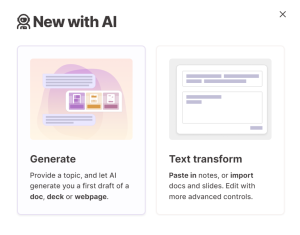
- Generate mode creates a presentation based on the prompt provided.
- Text to Transform mode allows you to provide information to be included in the presentation by writing in the text box, copying and pasting from another source, or importing from a document or slides.
- Select Presentation.
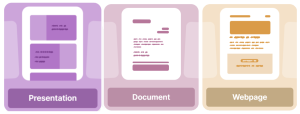
- If importing information using Text to Transform mode, upload the file and the information will appear in the text box for your review. You can adjust the presentation length and image licensing as needed.
- Provide instructions (prompt) for the AI to follow in the creation of your presentation.
- Press Generate.
- If using Generate mode, Gamma AI will produce an outline for your review. If it is unsatisfactory, you can edit to your liking or press “try again”. When done, press Continue.
- Pick a theme for your presentation.
- The AI icon at the top of the tool menu on the right side can provide suggestions for possible improvements.
- Users can ask the AI editor to help edit the content of the presentation, search for relevant images, and reformat slides.
- Users can highlight specific text and request a particular type of change be made.
- You can manually edit your cards (slides) using the other tools in the menu:
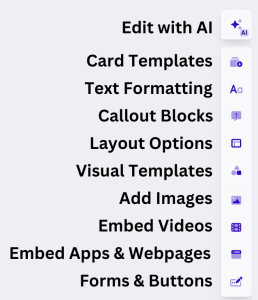
- Text formatting
- Callout blocks to add emphasis
- Layout options such as columns, tables, bullet lists, and timelines
- Visual templates to create various diagrams
- Embed videos to include audio and video content from a variety of sources, including YouTube, Loom, Spotify, and TikTok
- Embed apps & webpages to incorporate Google docs, sheets, and slides; Microsoft Word, Excel, PowerPoint, and OneNote; pdfs; webpages; and more
- Forms & buttons to embed forms (Jotform, Google form, etc.) and buttons which open links to websites or email
- Share the presentation with others, for consumption or collaboration:
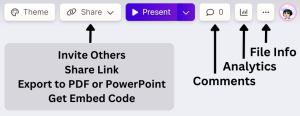
- Present live
- Share as a link
- Invite others to join
- Export to PowerPoint or PDF
- Incorporate into other pages, such as a Learning Management System (LMS), using the embed code.
Prompt Engineering
As with all ChatGPT-based tools, it’s important to provide detailed conditions and expectations in prompts. Be sure to specify the role of the AI, the tone needed, the intended audience, formatting preferences, and any other constraints (such as presentation length or vocabulary level). Theoretically, the more specific the prompt, the more likely Gamma is to produce a satisfactory outline and presentation. Initial testing of Generate mode with both broad and specific prompts seemed to produce more satisfactory outcomes than when using Text to Transform; while individual experiences may vary, this suggests that the method of generating the presentation may play as big of a role as the prompt itself.
Recommendations
To better understand Gamma’s features:
- review the Change Log to learn about the current and upcoming features.
- read their Frequently Asked Questions page.
To build further understanding of AI tools:
- Explore Gamma’s tools for creating documents and webpages.
- Continue to build your prompt literacy.
- Learn more about teaching with AI from OpenAI, the creators of ChatGPT.
- Review Nick Jackson’s SAMR Chatbots Model as you continue to develop ways to effectively integrate AI technology into your educational practices.
- Try using Ludia, an AI chatbot that helps users understand and incorporate UDL practices.
- Consider exploring other AI-powered presentation platforms, such as Tome.
Informative presentation
Learn more about using Gamma by clicking the image below. The volume can be turned on by clicking the center of the screen at the start of the presentation or by clicking in the bottom right corner of the player at any time.
References
Ai-dung, T. & Hung, W. (2022). The Effects of Microlearning: A Scoping Review. Educational Technology Research and Development, 70(2), 363–395. https://doi.org/10.1007/s11423-022-10084-1
CAST. (2018). Universal Design for Learning Guidelines (Version 2.2). http://udlguidelines.cast.org
Furze, L. (2023, August 7). AI Principles to Practical Strategies: How Schools Can Apply the National AI Framework. Leon Furze. AI Principles to Practical Strategies: How Schools Can Apply the National AI Framework – Leon Furze
Furze, L. (2023, September 12). UNESCO Guidelines for Generative AI: Practical Applications for Schools. Leon Furze. https://leonfurze.com/2023/09/12/unesco-guidelines-for-generative-ai-practical-applications-for-schools/
Gamma Tech, Inc. (2022). Privacy Policy. https://gamma.app/privacy
Gamma Tech, Inc. (2023) Gamma Tech, Inc. Terms of Use Agreement (Version 1.0) https://gamma.app/terms
Kurt, S. (2023, September 20). SAMR Model: Substitution, Augmentation, Modification, and Redefinition. Educational Technology. https://educationaltechnology.net/samr-model-substitution-augmentation-modification-and-redefinition/
OpenAI [@OpenAI]. (2023, September 27). ChatGPT can now browse the internet to provide you with current and authoritative information, complete with direct links to sources. [Image attached][Tweet]. X. https://twitter.com/OpenAI/status/1707077710047216095?s=20
Playground AI. (2023). Playground AI [Large language model]. https://playgroundai.com/
Quora, Inc. (2023). LUDIA – Poe [Large language model]. https://poe.com/Ludiachatbot
Acknowledgement of AI Use
LUDIA, the UDL AI chatbot, was consulted during topic exploration and inspired the reference to UDL.
Stable Diffusion XL was used within the Playground AI platform to create the Figures featured.
Gamma’s AI software was used to develop knowledge of the platform and tools, but was not used to generate the information presented. The Gamma presentations shown in the video were used for demonstration purposes only and were done after the drafting of this chapter.

